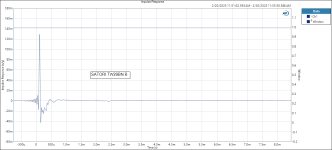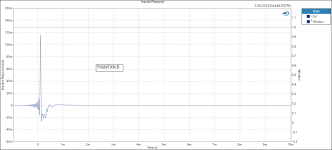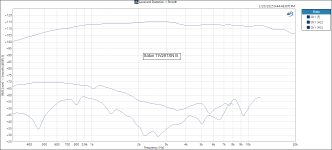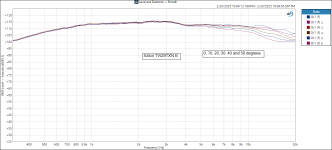Hello All,
I took the plunge,
Today I received from Madisound a pair of Purifi 6 – ½ inch Aluminum mid-woofers and a pair of Satori Textreme 29MM tweeters.
I also have on hand a pair of Satori Beryllium tweeters to audition.
See the attached links to the data sheets below.
This is planned to be two-way Bench-top speakers with a summed subwoofer tucked on the shelf below.
Look at the Purifi data sheet and you will notice that below ~ 125Hz that the Harmonic Distortion takes a steep climb. The crossover to the sub will remove the long excursion Low Frequencies from the Purify mid-bass driver. With the LF removed there is expected to be reduced intermodulation with the higher frequency voice content of the program material.
Purifi PTT6.5X04-NAA-08 6.5"
Satori TW29TXN-B-4 / TeXtreme Dome Tweeter
https://www.madisoundspeakerstore.c...tori-tw29txn-b-4/textreme-dome-tweeter-4-ohm/
https://www.madisoundspeakerstore.c...tw29bn-b-beryllium-dome-tweeter-black-flange/
https://purifi-audio.com/document/share/16/6b6d90f3-b9db-4eaa-9f36-9d424bd2adba
To start the crossover will be a active Rane Mojo MX23 that Is already on the shelf. There is a switchable factory summed sub-woofer output. The tweeters and mid-woofers will be driven by the XLR “HF” and “mid” outputs on the back side of the active crossover. The crossover frequencies are adjustable.
The Purifi site has a discussion about using series notch filters with the Purifi driver to notch out the 5kHz and ~ 9.5kHz resonate peaks from the Frequency Response. This is worth an effort. I think
A approximate 6 Liter sealed enclosure will used to start the Proto process.
Thanks DT
I took the plunge,
Today I received from Madisound a pair of Purifi 6 – ½ inch Aluminum mid-woofers and a pair of Satori Textreme 29MM tweeters.
I also have on hand a pair of Satori Beryllium tweeters to audition.
See the attached links to the data sheets below.
This is planned to be two-way Bench-top speakers with a summed subwoofer tucked on the shelf below.
Look at the Purifi data sheet and you will notice that below ~ 125Hz that the Harmonic Distortion takes a steep climb. The crossover to the sub will remove the long excursion Low Frequencies from the Purify mid-bass driver. With the LF removed there is expected to be reduced intermodulation with the higher frequency voice content of the program material.
Purifi PTT6.5X04-NAA-08 6.5"
Satori TW29TXN-B-4 / TeXtreme Dome Tweeter
https://www.madisoundspeakerstore.c...tori-tw29txn-b-4/textreme-dome-tweeter-4-ohm/
https://www.madisoundspeakerstore.c...tw29bn-b-beryllium-dome-tweeter-black-flange/
https://purifi-audio.com/document/share/16/6b6d90f3-b9db-4eaa-9f36-9d424bd2adba
To start the crossover will be a active Rane Mojo MX23 that Is already on the shelf. There is a switchable factory summed sub-woofer output. The tweeters and mid-woofers will be driven by the XLR “HF” and “mid” outputs on the back side of the active crossover. The crossover frequencies are adjustable.
The Purifi site has a discussion about using series notch filters with the Purifi driver to notch out the 5kHz and ~ 9.5kHz resonate peaks from the Frequency Response. This is worth an effort. I think
A approximate 6 Liter sealed enclosure will used to start the Proto process.
Thanks DT
Last edited:
Is there anything new about this? I'm more or less on the same path - 2.1 with PTT6.5X04-NAA-08 limited down at 60Hz and ESS AMT-1 or SB Acoustics SB26ADC-C000-4 in the Monacor WG-300 waveguide.
Looks good.
I am not too concerned about a wave guide for the tweeter for direct / near field listening.
Still scratching my head.
I think that I will include in the mix a 17 Liter sealed enclosure. The WinISD model shows a F3 of about 80Hz and a Qtc of ~0.48. The concept is the enclosure is more of an infinite baffle than air suspension. The compressed air in the larger sealed enclosure will have less effect on the cone of the driver
Turn off the woofer for late night listening.
Thanks DT
I was about to suggest that you build a larger enclosure than you considered in your first posting. The volume can be reduced subsequently, e.g. by inserting closed-cell PE foam blocks, which can then be wedge-shaped or otherwise to achieve acoustically favorable inner enclosure shapes.
Keep us up to date! My Purifis will be arriving soon, until then I have to think about how to bring the recessed driver cut-outs on my existing enclosures from 166 to 177 mm without botching them.
Keep us up to date! My Purifis will be arriving soon, until then I have to think about how to bring the recessed driver cut-outs on my existing enclosures from 166 to 177 mm without botching them.
Hello All,
Went out in the garage and located a 0.55 ft^3, 15L Denovo enclosure that was previously used to measure an other version of the Purify 6 1/2 inch driver. The opening needed a little reaming with a half round file for this new aluminum to fit. Fortunately the bolt circle was the same. The small random amount of polyester stuffing remained.
Sort of down and dirty look at measurements in the mid- bass driver in the Denovo enclosure. The measurements were taken at a unmeasured 1 inch away, a unmeasured center of the driver at 0.5 volts from the Audio Precision APx 1701 test interface.
With my hand lightly touching the top or side of the enclosure I could feel a moderate amount of vibration during the 5 second 20Hz to 10KHz test frequency sweep.
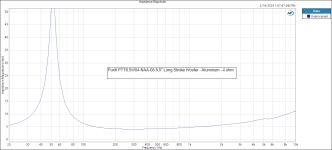
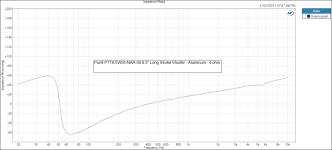
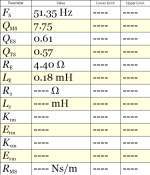
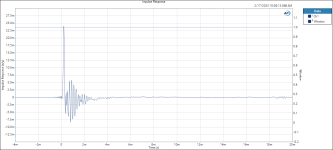
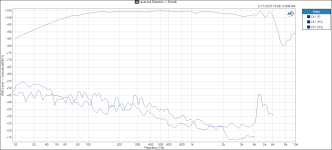
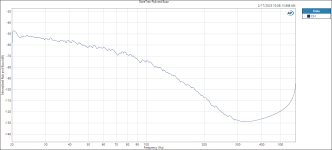
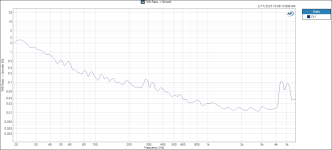
Went out in the garage and located a 0.55 ft^3, 15L Denovo enclosure that was previously used to measure an other version of the Purify 6 1/2 inch driver. The opening needed a little reaming with a half round file for this new aluminum to fit. Fortunately the bolt circle was the same. The small random amount of polyester stuffing remained.
Sort of down and dirty look at measurements in the mid- bass driver in the Denovo enclosure. The measurements were taken at a unmeasured 1 inch away, a unmeasured center of the driver at 0.5 volts from the Audio Precision APx 1701 test interface.
With my hand lightly touching the top or side of the enclosure I could feel a moderate amount of vibration during the 5 second 20Hz to 10KHz test frequency sweep.







Last edited:
PTT6.5X04-NAA-08 in 17 liters* sealed

Not calibrated to level at 3 cm distance on axis


(* 17 liters are estimated - all inner walls are lined with 1 cm thick, hard, high-density wool felt. I don't know whether to consider it solid or porous or something in between. otherwise loosely lined with polyfill.)
Not calibrated to level at 3 cm distance on axis
(* 17 liters are estimated - all inner walls are lined with 1 cm thick, hard, high-density wool felt. I don't know whether to consider it solid or porous or something in between. otherwise loosely lined with polyfill.)
Easiest way is to put a flat board across the previous open hole, affix it with screws to the recessed area. Mark the exact center of the previous hole, and drill out the center hole for a router jig. Then use a hand router & circle jig set to 177mm to transcribe the new recess width.how to bring the recessed driver cut-outs on my existing enclosures from 166 to 177 mm without botching them.
Sometimes it may be easier to affix the board from the backside of the hole, and use thin screws thru the original speaker screw holes to draw the board up tight to the hole. Upu can then use a spacer board on top of that to equal the speaker face for easy router work.
Inexpensive hand routers work fine. Mine was $30 from Harbor Freight and a $15 circle jig. You may want to invest in a nicer bit for an extremely clean cut if your speaker face is veneered.
@Groundloops
Your sanity check sweeps look very similar.The next day or two I will do like tests with the Santori tweeters.
Thanks DT
I simply placed them on the baffle without a recess. In my application, this is probably not a major disadvantage. Unfortunately, they are not really nice to look at ...Easiest way is to put a flat board across the previous open hole, affix it with screws to the recessed area. Mark the exact center of the previous hole, and drill out the center hole for a router jig. Then use a hand router & circle jig set to 177mm to transcribe the new recess width. ...
They look great! I would recommend switching the screws to something other than Philips tho. Either square or star looks really nice and finished, and tends to blend well. Plus, those two screw heads are MUCH less likely to slip when screwing/unscrewing, and safer against risk of scratching the frame or puncturing the surround.Unfortunately, they are not really nice to look at ...
Hello All,
Looking at the The Satori tweeters. From 6 inches away they look the same, fit in the same baffle opening and measure the "same".
Thoughts?
Has any one listened to both the beryllium and the TeXtreme versions of the Satori tweeters?
Thanks DT
Looking at the The Satori tweeters. From 6 inches away they look the same, fit in the same baffle opening and measure the "same".
Thoughts?
Has any one listened to both the beryllium and the TeXtreme versions of the Satori tweeters?
Thanks DT
Polars to compare them..Thoughts?
Polars to compare them..
That is a good thought.
I have not yet downloaded from AP the the waterfall and polar plot plugins for the current v9.0 APx500 software.
My estimate is that the crossover frequency will work out somewhere between 2 and 3 kHz. The mid-woofer should not be beaming yet and should transition fairly smoothly to either tweeter. The crossover nulls will be a bigger deal for vertical dispersion. 24 dB slopes will help.
I think that I will fabricate a pair of plywood test speakers to see how they play and by then I will have sorted the waterfall and polar test plots.
A simulation based on own measurements of SPL (REW) and Z (DATS V3):
light blue - bare driver
dark blue - with notch filter and zobel
brown - with 12db active low pass + notch filter + zobel
What do you think - can the be better or should it be better? Should I also attenuate the peak at 10k? I will hardly work with a shallower low pass btw.

light blue - bare driver
dark blue - with notch filter and zobel
brown - with 12db active low pass + notch filter + zobel
What do you think - can the be better or should it be better? Should I also attenuate the peak at 10k? I will hardly work with a shallower low pass btw.
Hello All,
I took the plunge,
Look at the Purifi data sheet
Purifi PTT6.5X04-NAA-08 6.5"
https://purifi-audio.com/document/share/16/6b6d90f3-b9db-4eaa-9f36-9d424bd2adba
The Purifi site has a discussion about using series notch filters with the Purifi driver to notch out the 5kHz and ~ 9.5kHz resonate peaks from the Frequency Response. This is worth an effort. I think
Thanks DT
Look up the notch filter discussion about removing the resonance and distortion peaks on the purifi site.
from the point of measuring it and learning about it I plan to test the notch filters.
In this case, why not first see there isn’t already enough series impedance before going to the trouble.
Rather than making the simulator assumptions, I plan to fab the enclosures with Owens Corning 1 inch Type 703 unfaced fiberglass Insulation Board near the enclosure walls and the interior space moderately stuffed with light fluffy fiberglass.
My "sanity test" Frequency Response previously posted does not show the degree of resonance indicated on the Purifi Data Sheet.
We will see.
Thanks DT
My "sanity test" Frequency Response previously posted does not show the degree of resonance indicated on the Purifi Data Sheet.
We will see.
Thanks DT
- Home
- Loudspeakers
- Multi-Way
- Purifi / Satori, Bench Top 2.1 Speakers
